Exploring the culinary delights of Japan, one can embark on a hands-on journey to master the art of making onigiri, the beloved rice balls. Nestled in the heart of Tokyo, a professional cooking studio offers an engaging 3-hour class where participants can learn the intricate techniques of shaping and filling these traditional treats. Guided by an English-speaking instructor, guests will discover the flavors of pickled plum and bonito flakes while seeing Japan’s rich gastronomic culture. With a communal lunch featuring the onigiri creations, this experience promises to be a delightful exploration of the country’s renowned culinary heritage.
Key Points
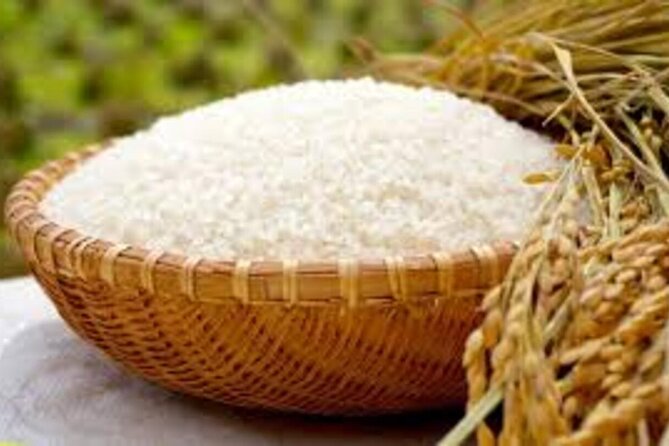
- Participants create traditional Japanese onigiri (rice balls) with various fillings at a professional cooking studio in Tokyo.
- The 3-hour cooking class has a maximum of 6 travelers and includes instruction on making tamagoyaki, pickled vegetables, and miso soup.
- The cooking studio is located in the Kokusai Building in Marunouchi, with easy access via multiple metro lines and a 3-minute walk from the Tokyo International Forum.
- Participants wear aprons, chef’s hats, and kitchen towels, and receive hands-on experience in shaping and filling onigiri with classic flavors like pickled plum and bonito flakes.
- The class has a cancellation and refund policy, with full refunds available for cancellations due to unavoidable circumstances and up to 24 hours before the class.
Overview of the Onigiri Cooking Class

The onigiri cooking class at the professional cooking studio in Tokyo offers participants a unique hands-on experience in creating traditional Japanese rice balls.
Hosted in the Kokusai Building in Marunouchi, the class allows up to 6 travelers to learn from an English-speaking instructor.
Participants will make onigiri with fillings like pickled plum and bonito flakes, accompanied by tamagoyaki, pickled vegetables, and miso soup.
The 3-hour class starts at 11 AM and includes all necessary cooking equipment and ingredients.
The class isn’t wheelchair accessible and has age and height requirements.
Want to bring Tokyo's flavors home? More hands-on cooking experiences we cover
Getting to the Cooking Studio
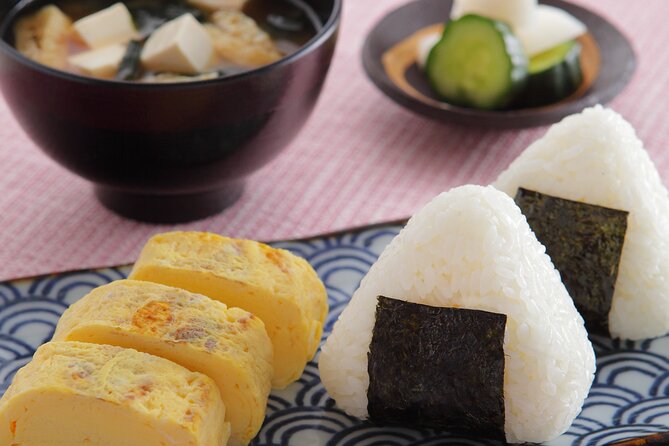
Accessible via the Metro Hibiya Line, Chiyoda Line, Toei Mita Line, and Yurakucho Line, the Marunouchi ABC Cooking Studio is located on the B2 floor of the Kokusai Building.
A 3-minute walk from the Tokyo International Forum, the studio is easy to reach. Follow the signs to Hibiya Station, then take the underground walkway to the Kokusai Building.
The cooking class meeting point is on the B2 floor. Detailed directions are provided, ensuring travelers find the studio without issue.
With convenient metro access and a short walking distance, getting to the onigiri cooking class is straightforward.
What to Expect in the Class
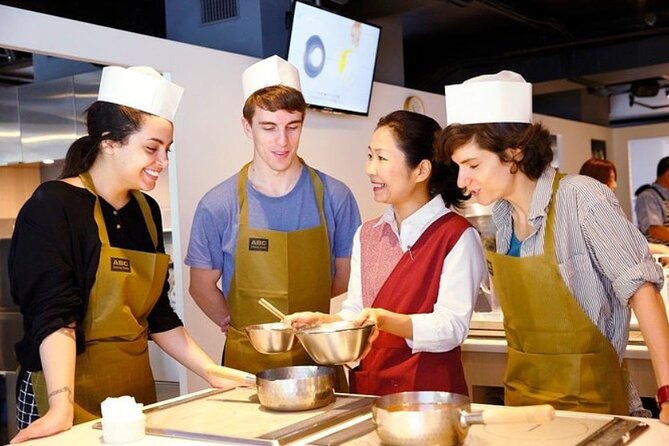
Participants begin the onigiri cooking class by donning the provided aprons, chef’s hats, and kitchen towels, preparing to create their own handmade rice balls.
Under the guidance of an English-speaking instructor, they’ll learn the proper techniques for shaping and filling the onigiri. The menu includes classic fillings like pickled plum and bonito flakes, as well as a Japanese omelet and pickled vegetables.
After the hands-on cooking, participants enjoy a communal lunch of their creations along with miso soup.
The small class size of 6 travelers ensures personalized attention throughout the experience.
Preparing the Onigiri Fillings
As the class begins, the instructor demonstrates the proper techniques for preparing the onigiri fillings. Participants will create two classic flavors: pickled plum and bonito flake.
| Filling | Ingredients |
|---|---|
| Pickled Plum | Umeboshi (pickled plum), soy sauce, mirin |
| Bonito Flake | Katsuobushi (bonito flakes), soy sauce, mirin |
The instructor guides students through the steps – mashing the umeboshi, mixing the sauces, and gently incorporating the bonito flakes. Attention to detail is essential for achieving the perfect balance of sweet, salty, and savory flavors in the onigiri fillings.
Shaping the Onigiri
With the fillings prepared, the instructor demonstrates the proper technique for shaping the onigiri.
First, she scoops a handful of warm, slightly sticky rice. Cupping her hands, she gently squeezes and molds the rice into a triangular shape.
Deftly, she creates a well in the center and places a small amount of the pickled plum or bonito flake filling inside.
Skillfully, she closes her hands around the rice, applying gentle pressure to enclose the filling. The result is a perfectly formed onigiri, ready to be served.
Students eagerly follow the instructor’s lead, shaping their own unique rice balls.
- English Driver 1-Way Haneda Airport To/From Tokyo 23 Wards
- Mt Fuji & Hakone: Sightseeing Private Day Tour With Guide
- Tokyo City Customized Tour With English Speaking Guide
- Kanto 10-Hour Chartered Day Trip | Tokyo City
- Akihabara Culinary and Culture Adventure: Your Personalized
- Tokyo DisneySea: 1-Day Ticket & Private Transfer
Cooking the Tamagoyaki
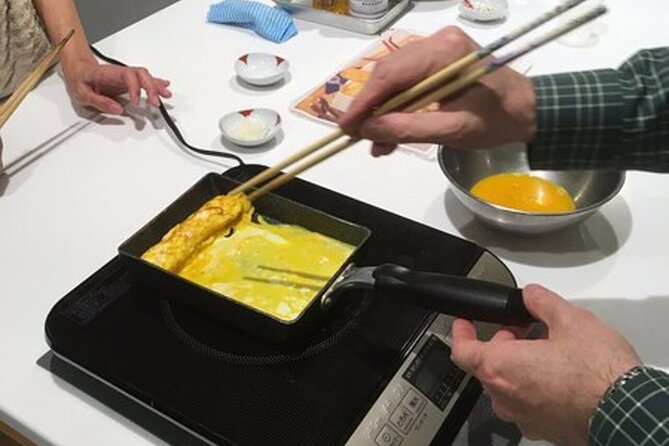
After mastering the art of shaping the onigiri, the class now turns its attention to the next dish – the preparation of the classic Japanese tamagoyaki. The instructor guides the participants through the process, demonstrating the intricate folding and rolling techniques required to create the perfect tamago-style omelet. Each student carefully pours the egg mixture into a specialized rectangular pan, skillfully manipulating the layers to achieve the signature layered appearance. The result is a beautifully presented, sweet and savory tamagoyaki, ready to be paired with the freshly made onigiri and other delectable accompaniments.
| Preparation Steps | Technique |
|---|---|
| 1. Whisk eggs | Combine eggs, sugar, and dashi |
| 2. Heat pan | Use specialized rectangular pan |
| 3. Pour egg mixture | Spread thinly and evenly |
| 4. Fold and roll | Carefully manipulate layers |
| 5. Slice and serve | Pair with onigiri and sides |
Enjoying the Miso Soup and Pickled Vegetables
The participants now turn their attention to the final components of the meal – the miso soup and pickled vegetables.
The fragrant miso broth, ladled into delicate bowls, warms the senses. Floating within are soft cubes of tofu and slivers of green onion, adding texture and depth.
The crisp, tangy pickled vegetables, a selection of carrots, cucumbers, and daikon radish, provide a refreshing counterpoint to the savory soup.
Together, the miso and pickles round out the meal, cleansing the palate and leaving the participants satisfied and content after their hands-on culinary experience.
Cancellation and Refund Policy
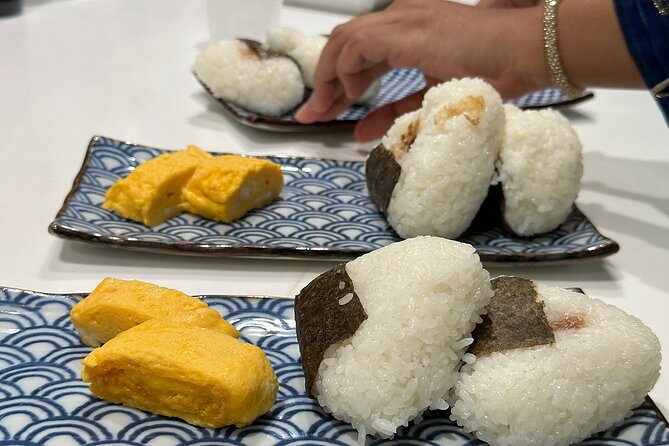
The cooking class offers a straightforward cancellation and refund policy. Guests can receive a full refund if they need to cancel due to unavoidable circumstances.
However, rescheduling requests won’t come with a refund. Visitors can cancel up to 24 hours before the start of the experience without any penalties. After that, there are no refunds.
Participants also can’t take any leftover food home. And strollers or large luggage aren’t permitted.
The studio emphasizes that reservation cancellations without refunds will occur if guests arrive late. Inquiries can be made via email, as phone support isn’t available at all hours.
Frequently Asked Questions
Can I Bring My Own Cooking Utensils to the Class?
No, personal cooking utensils are not allowed. The class provides all the necessary equipment and ingredients for making onigiri. Participants should come prepared to use the studio’s tools and follow the instructor’s guidance during the cooking session.
Is the Cooking Studio Open on National Holidays?
The cooking studio is not open on national holidays. The class is held on regular weekdays, with the schedule subject to change due to special events or closures. Customers are advised to check the availability before booking.
Are Vegetarian or Gluten-Free Options Available?
The overview doesn’t mention vegetarian or gluten-free options. Guests should contact the studio directly to inquire about any special dietary accommodations. The class focuses on preparing traditional Japanese onigiri fillings and dishes.
Is It Possible to Take the Leftovers Home?
No, participants are not allowed to take any leftovers home after the onigiri cooking class. The policy states that no takeaway is permitted following the meal. All food prepared during the class must be consumed on-site.
Do I Need to Pay a Deposit for the Class?
The cooking class doesn’t require a deposit. However, it has a strict no-takeaway policy, so participants can’t bring home any leftovers. The classes are limited to 6 travelers and have a minimum age requirement of 9 years old.
The Sum Up
The onigiri cooking class offers a unique opportunity to take in Japanese culinary traditions. Participants will learn the art of shaping and filling rice balls, creating a delicious and authentic meal complemented by traditional side dishes. This hands-on experience promises an engaging and memorable introduction to the rich flavors and techniques of Japanese cuisine.
More Cooking Classes in Tokyo
- Tokyo Learn Keen Japanese Knife and Sashimi Cooking Class
- Private Tsukiji Market Visit and Cooking Class in Junkos Home
- Create Kawaii Sushi in Tokyo Cooking Experience
- Toyosu Fish Market Private Tour and Cooking Experience
- Tokyo Umami Cooking Class With Oyakodon and Japanese Seasonings
- Tokyo Sushi and Cooking Class
More Tour Reviews in Tokyo
- Tokyo: Shinobi Samurai Premium EXP for Solo Travelers, 90min
- Mt Fuji Private Tour With English Speaking Driver
- Nerikiri Wagashi-Making With Tea Ceremony Review
- Tokyo 3-Hour Guided E-bike Cycling Tour of the Citys Hidden Gems
- Official Street Go-Kart Tour – Shinagawa Shop
- 【Open 1st Anniv.】Popular Sushi Making Class Near Tokyo Tower
Not for you? Here's more things to do in Tokyo we have recnetly reviewed
- 2 Best Craft Beer Tours And Tastings In Tokyo
- 20 Best 2 Day Tours In Tokyo
- 7 Best 3 Day Tours In Tokyo
- 6 Best 4 Day Tours In Tokyo
- 25 Best Cruises And Boat Tours In Tokyo
- 25 Best Food Tours In Tokyo
- 20 Best Full-Day Tours In Tokyo
- 15 Best Helicopter Flights And Tours In Tokyo
- 2 Best BBQ Experiences In Tokyo
- 5 Best Coffee Tours And Tastings In Tokyo
- 25 Best Lunch Experiences In Tokyo
- 12 Best Massage And Relaxation Services In Tokyo
